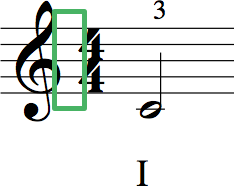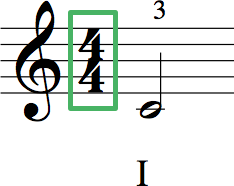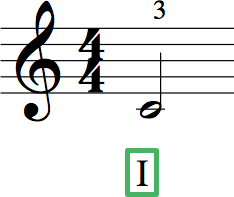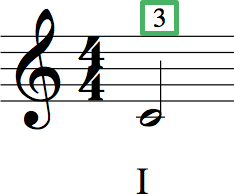Introduction to Reading Music
Before You Begin
You will need a very basic grasp of how to play notes or scales on the guitar, and beginning-level understanding of how written music notation works. At the very least you may wish to review these two lessons before continuing:
Why Should You Learn to Sight Read?
We can all think of at least one famous guitar player who never learned to read music. But we can also think of famous musicians who were blind, or even deaf. Few people would credit their success to a disability or to a skill they never learned.

Google autosuggest says: Don’t become a stereotype!
Imagine that you can open any of the hundreds of thousands of pages of sheet music ever written, and perform new music instantly with no rehearsal. Many musicians have learned to do that. And so will you, if you care to invest the time.
Below is a set of notes for us to to read. First, we’ll look at the information not specifically referring to notes. Think of this information like the name, cover and description of a book. It doesn’t tell you about the contents but it gives you an idea of what you can expect in the book.
Hints to Help You Read
Here are some of the things to consider before reading a piece of guitar music:
Key Signature

This one can be a challenge because the first music you sight read will not have a key signature. That’s because music with no key signature is often in the key of C major, like this example. Otherwise, the key signature will give information about what notes are modified for the duration of this piece of music. For instance, a key signature with an F♯ means that, unless specified otherwise, all instances of “F” are “F♯”. (More information on reading key signatures…
The default key signature (i.e., no key signature) means that all notes will be naturalA note that is unaltered by sharp or flat; i.e., one of the notes of the C major scale: C,D,E,F,G,A or B. unless an accidentalAny named note whose pitch is modified by a sharp (♯) or flat (♭) symbol. This even includes notes that are returned to a non-sharp or non-flat by the natural symbol (♮). is written next to the note.
Time Signature

This one is also unclear in the beginning because most music you see at first will use something called a “common time” signature by default. In common time, the music is grouped into four main pulses. Most popular songs fit this description. For now, don’t worry about it too much.
Position Markings

Found only on guitar music. Indicated by Roman numeralsRoman numerals are often used to indicate fret positions (I, III, VII, etc.), position markings indicate the fret at which the first finger is placed. The Roman numeral III means that the first finger plays all notes on fret III, the second finger plays all notes at fret IV. The lowest note would be a note on fret II played by the first finger temporarily stretched out of its place. This is important. If someone writes fret position V, it means that that they felt it was substantially easier or better to play the passage at fret V than anywhere else.
Finger Markings

Indicated by Arabic numeralsArabic numerals (“1”, “2”, “3” can be used to mark fingerings used in reading guitar music., finger markings allow the composer to show the player what fingers should be used to play each note. Normally, the composer chooses to do this because he or she is a guitar player, and has determined that a particular fingering will have a bad result and that an alternative is better. Like fret markings, if present they should be considered. However, if the player is not observing the fret marking information, the finger marking information is also not useful.
Sight-Reading Example 1

Let’s review the available information: No key signature suggests a key of C major. Four over four means common time.
Note that the fret indicator is Roman numeral I. The best way to play the first note is with the ring finger. Any other finger would compromise the fret position by forcing you to move the index finger.
If we ask 100 players to observe these “rules” they’ll all play it almost the same way. It’s a C major scale, starting on the fret III of string 5, and ending on fret I of string 2. Go ahead and play it. If you’re stuck here, you probably need to review the names of the musical notes on the staff, and the names of the notes on the first five frets of the guitar.
Sight-Reading Example 2

The fret position is V. Move the first finger to the fret V. Now, there is no other way to play the first note, “C”. It must be played at fret VII of string 6, using the pinky finger. The rest of the notes can only be played in one way as well, with the exception of the “B”. This can be a stretch to fret IX using the pinky, or a stretch to fret IV using the first finger. Stretching with the pinky would make it a bit harder to reach the “C” on fret V of the 3rd string, and would also tempt you to play the C on fret X of the fourth string, which would be out of bounds. For this reason, the composer has indicated which finger you should use, to help guide you away from shifting out of the position.
Same musical results, but different ways to play the same notes. This is what differentiates sheet musicSheet music is also called standard music notation. It can be used to notate rhythms, pitches and harmonies for any instrument. from tablatureTablature is a form of notation for fretted instruments, especially guitar. It indicates what specific frets should be played. .
Many teachers who demonstrate sight-reading emphasize that students should first find the position that the piece is in, and second play the scale relating to the key that the piece is in. In this case, you have now done that process for both position I and position V. Let’s try a few melodies. For best results, you should try playing the melodies in both positions.
Sight-Reading Example 3

Key Result
- Make sure you can read the simple melody above.
- Be sure you can identify the notes on the musical staff. See this notation lesson if you need more help.
 As the creator of Hub Guitar, Grey has compiled hundreds of guitar lessons, written several books, and filmed hundreds of video lessons. He teaches private lessons in his Boston studio, as well as via video chat through TakeLessons.
As the creator of Hub Guitar, Grey has compiled hundreds of guitar lessons, written several books, and filmed hundreds of video lessons. He teaches private lessons in his Boston studio, as well as via video chat through TakeLessons.